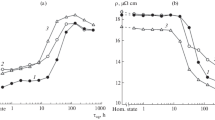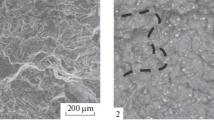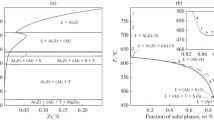Abstract
THE remarkable changes in properties which may be achieved by the addition of small quantities, or traces, of certain elements to age-hardening alloy systems has aroused much interest recently. A notable example is the pronounced effect of traces of cadmium, indium, or tin on the elevated temperature ageing characteristics of aluminium–copper alloys1. Similar observations have been made in a number of alloys; but, with the exception of a study of trace element additions to ternary aluminium–copper–lithium alloys2, investigations have been confined to binary systems.
Similar content being viewed by others
References
Hardy, H. K., J. Inst. Metals, 78, 169, 657 (1950–51); 80, 483 (1951–52).
Hardy, H. K., J. Inst. Metals, 84, 429 (1955–56).
Polmear, I. J., J. Inst. Metals, 86, 113 (1957–58).
Author information
Authors and Affiliations
Rights and permissions
About this article
Cite this article
POLMEAR, I. A Trace Element Effect in Alloys based on the Aluminium-Zinc-Magnesium System. Nature 186, 303–304 (1960). https://doi.org/10.1038/186303a0
Issue Date:
DOI: https://doi.org/10.1038/186303a0
- Springer Nature Limited
This article is cited by
-
An Analysis of Strengthening Mechanisms and Rate-Dependence in a High Strength Aluminum Alloy
Journal of Dynamic Behavior of Materials (2018)
-
Effects of Germanium, Copper, and Silver Substitutions on Hardness and Microstructure in Lean Al-Mg-Si Alloys
Metallurgical and Materials Transactions A (2015)
-
Effect of trace additions of cadmium, silver and zirconium on the precipitation hardening behavior of aluminum 6061 alloy
Transactions of the Indian Institute of Metals (2009)
-
Effect of low temperature aging on microstructure and mechanical properties of super-high strength aluminum alloy
Journal of Central South University of Technology (2006)
-
Simulation of clusters formation in Al-Cu based and Al-Zn based alloys
Journal of Materials Science (2005)





